AMD's FSR 4: A Leap Towards AI-Powered Graphics Enhancement
2 Sources
2 Sources
[1]
AMD FSR 4 To Go The Full "AI" Route, Follows NVIDIA DLSS & Intel XeSS To Deliver Better Visual Fidelity
AMD's next-gen FidelityFX Super Resolution technology known as FSR 4 will be leveraging AI in a grander scale to improve visual fidelity. AMD Finally Ready To Adopt AI For FidelityFX Super Resolution Technology: FSR 4 To Enhance Image Quality & Improve Efficiency Talking to AMD's SVP & GM of Computing and Graphics Business Group, Jack Huynh, during IFA 2024, Tomshardware managed to confirm some details of the next-generation FidelityFX Super Resolution suite and it looks like the red team is finally ready to adopt AI for upscaling which the competition has been using for the past few generations. The adoption of AI in the Radeon architecture has been anticipated by many but many had doubts if AMD would use it for use cases such as its FSR tech. Last year, AMD stated that they had different plans for AI beyond upscaling. The specific quote from David Wang stated that accelerators for AI inferencing should be used to make games for advanced and fun. We believe that inference accelerators that should be implemented in gamers' GPUs should be used to make games more advanced and fun. AMD SVP of Radeon Technologies Group, David Wang (Machine Translated via 4Gamer) However, earlier this year, AMD teased that it was going to adopt AI for its next-generation FSR tech as 2024 will mark a huge deployment year for them. 2024 for us is a huge year because we have spent so many years developing hardware and software capabilities for AI. We've just completed AI enabling our entire portfolios so cloud, edge, PCs, our embedded devices, our gaming devices, we're enabling our gaming devices to upscale using AI and 2024 is really a huge deployment year for us so now the bedrock's there, the capabilities are there. Mark Papermaster (AMD CEO) via No Priors It seems like the new management at the AMD Radeon division has now taken the covers off of their surprise tech which is FSR 4 and that will indeed incorporate AI. For reference, NVIDIA has leveraged AI in its DLSS technologies since 2018 and managed to fine-tune and optimize it in the subsequent versions with DLSS Frame-Gen and DLSS Ray-Reconstruction also leveraging full use of AI to deliver better visual fidelity. Meanwhile, Intel's XeSS has incorporated AI through the use of XMX accelerators and further refined it in the latest 1.3.1 SDK. AMD itself has been enhancing FSR 3.1 and AFMF using AI but it looks like the next step is to harness both software and hardware-based AI additions to deliver a better experience to gamers. With FSR 4, AMD isn't just going to deliver better upscaling but offer both Frame generation and frame interpolation to extend not just battery times on handhelds but also to enhance visuals and performance on discrete GPUs. On the handheld side, my number one priority is battery life. If you look at the ASUS ROG Ally or the Lenovo Legion Go, it's just that the battery life is not there. I need multiple hours. I need to play a Wukong for three hours, not 60 minutes. This is where frame generation and interpolation [come in], so this is the FSR4 that we're adding. So now we're going AI-based frame generation, frame interpolation, and the idea is increased efficiency to maximize battery life. Jack Huynh (AMD SVP & GM) - via Tomshardware AMD recently rolled out a brand new SoC for the Sony PlayStation 5 Pro which features PSSR or PlayStation Spectral Super Resolution technology. This is a fully AI-enabled upscaling technology and it is highly likely that it is based on the same fundamentals and algorithms as FSR 4 but with some console-specific optimizations. The SoC also incorporates an upgraded RT engine thanks to the backporting of RDNA 4 technologies on this specific chip. AMD's FidelityFX Super Resolution "FSR 4" technology is expected to debut next year with the launch of AMD's RDNA 4 GPUs which will mark a new era of the Radeon graphics segment. The lineup will start by aiming at the mainstream segment first and move towards the unification of both RDNA and CDNA families for consumers and data centers under the UDNA series. Expect AMD to share more GPU updates in the future.
[2]
AMD plans for FSR4 to be fully AI-based -- designed to improve quality and maximize power efficiency
The team in charge has already been working on this for 9-12 months. We spoke at length with AMD's Jack Huynh, senior vice president and general manager of the Computing and Graphics Business Group, at IFA 2024. Along with deprioritizing flagship gaming GPUs and announcing the intent to create a unified UDNA GPU architecture to take on Nvidia's CUDA, the final major topic that he talked about is FSR4, FidelityFX Super Resolution 4.0. What's particularly interesting is that FSR4 will move to being fully AI-based, and it has already been in development for nearly a year. The comments came as Huynh was talking about handheld gaming and battery life, but based on AMD's history of open-source, architecture-agnostic algorithms, FSR4 should be for more than just handhelds. We've edited and cleaned up the text from our recording, and here's what was said. Jack Huynh: On the handheld side, my number one priority is battery life. If you look at the ASUS ROG Ally or the Lenovo Legion Go, it's just that the battery life is not there. I need multiple hours. I need to play a Wukong for three hours, not 60 minutes. This is where frame generation and interpolation [come in], so this is the FSR4 that we're adding. Because FSR2 and FSR3 were analytical based generation. It was filter based. Now, we did that because we wanted something with a very fast time to market. What I told the team was, "Guys, that's not where the future is going." So we completely pivoted the team about 9-12 months ago to go AI based. So now we're going AI-based frame generation, frame interpolation, and the idea is increased efficiency to maximize battery life. And then we could lock the frames per second, maybe it's 30 frames per second, or 35. My number one goal right now is to maximize battery life. I think that's the biggest complaint. I read the returns too from the retailer, where people want to be able to play these games. [End quote] It's interesting that the initial context for FSR4 seems to completely ignore how it might be used on non-handheld devices. And even then, it's about battery life rather than performance. Does that mean FSR4 will specifically need some of the features like the NPU on the latest Strix Point processors? We don't know, and we've reached out to AMD for clarification. But we suspect that's not the case. As noted above, AMD's history with FSR is to support a wide range of GPU solutions. Going AI-based doesn't inherently preclude the use of GPUs either, as any recent GPU from the past six years at least can run both FP16 and DP4a (INT8) instructions that overlap with things like tensor cores and NPU instructions. Intel has already taken a similar approach with XeSS, where it can run in XMX mode on Arc GPUs that have the Xe Matrix eXtensions. And for GPUs that don't have XMX support -- like everything from AMD and Nvidia, as well as older Intel graphics solutions plus the integrated Arc Graphics in Meteor Lake processors -- XeSS can use DP4a instructions to do similar work. The total compute available tends to be lower with DP4a, so it's not the exact same model being used, but more recent versions like XeSS 1.3 have focused on improving the quality and performance of the DP4a code path. Plenty of questions remain with FSR4, like when it will even become available. If it's already been in development for 9-12 months, it could be very nearly ready for release. But as we've seen with past upscaling solutions, including DLSS and XeSs alongside FSR 1/2/3, releasing the API merely represents the first step. Getting games to support the new API takes longer. AMD also just updated its Fluid Motion Frames 2 (AFMF 2) technology, which provides a driver-level solution for frame generation. That's probably the near-term solution for handheld gaming devices looking to boost performance, though as with all framegen solutions that rely on interpolation, we note that it's more frame smoothing than a true performance boosting feature. Will that be enough, and will FSR4 usher in a truly competitive alternative to DLSS and XeSS that finally leverages AI? We'll find out when AMD releases it to the public.
Share
Share
Copy Link
AMD is developing FSR 4, an AI-based graphics upscaling technology, to compete with NVIDIA's DLSS and Intel's XeSS. This new version aims to improve visual quality and power efficiency in gaming.

AMD Unveils Plans for FSR 4: An AI-Driven Graphics Revolution
AMD has announced its plans to develop FidelityFX Super Resolution 4 (FSR 4), the next iteration of its graphics upscaling technology. This upcoming version marks a significant shift for AMD, as it will be fully AI-based, aligning with competitors NVIDIA's Deep Learning Super Sampling (DLSS) and Intel's Xe Super Sampling (XeSS) technologies
1
.The Evolution of FSR Technology
FSR has undergone several iterations since its introduction. The current version, FSR 2, uses temporal upscaling without AI, while FSR 3 introduced frame generation. With FSR 4, AMD aims to leverage artificial intelligence to enhance visual fidelity and maximize power efficiency
2
.AI-Powered Enhancements
The move to AI-based upscaling is expected to bring several benefits:
- Improved Visual Quality: AI algorithms can potentially deliver sharper, more detailed images compared to traditional upscaling methods.
- Better Performance: AI-driven solutions may offer improved frame rates without sacrificing image quality.
- Power Efficiency: AMD is focusing on maximizing power efficiency, which could lead to better performance on laptops and other power-constrained devices
2
.
Competition in the GPU Market
FSR 4's development comes as AMD faces stiff competition from NVIDIA's DLSS 3.5 and Intel's XeSS. Both competitors have already implemented AI-based upscaling solutions, putting pressure on AMD to catch up
1
.Related Stories
Challenges and Considerations
While the move to AI-based upscaling is promising, AMD faces several challenges:
- Hardware Requirements: It's unclear whether FSR 4 will require specific hardware, like NVIDIA's Tensor cores, or if it will be compatible with a wide range of GPUs.
- Development Time: The timeline for FSR 4's release remains uncertain, potentially giving competitors more time to refine their technologies
2
. - Balancing Quality and Compatibility: AMD will need to ensure that FSR 4 provides significant improvements while maintaining broad compatibility across different hardware configurations.
Impact on the Gaming Industry
The development of FSR 4 could have far-reaching implications for the gaming industry:
- Enhanced Gaming Experience: Improved upscaling technologies can deliver better visuals and performance across a wide range of hardware.
- Increased Competition: AMD's entry into AI-based upscaling may drive further innovation in the field.
- Potential for Cross-Platform Support: If FSR 4 maintains hardware agnosticism, it could see widespread adoption across various platforms and devices
1
.
References
Summarized by
Navi
[1]
Related Stories
AMD's FSR 4.0: AI-Powered Upscaling for Enhanced Gaming Performance and Battery Life
16 Sept 2024

AMD's FSR 4: AI-Powered Upscaling Exclusive to RDNA 4 GPUs Promises Significant Improvements
07 Jan 2025•Technology

AMD Unveils FSR 4: AI-Powered Upscaling Technology Exclusive to RDNA 4 GPUs
28 Feb 2025•Technology

Recent Highlights
1
AI Chatbots Sway Voters More Effectively Than Traditional Political Ads, New Studies Reveal
Science and Research

2
Trump signs executive order to override state AI laws despite bipartisan pushback
Policy and Regulation

3
OpenAI warns upcoming AI models will likely pose high cybersecurity risk with zero-day exploits
Technology





